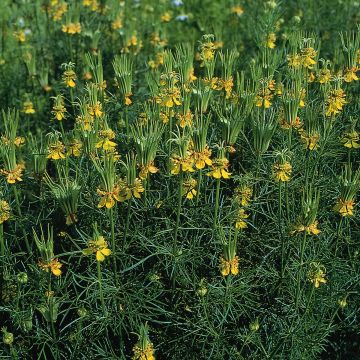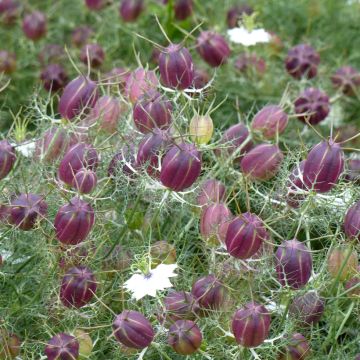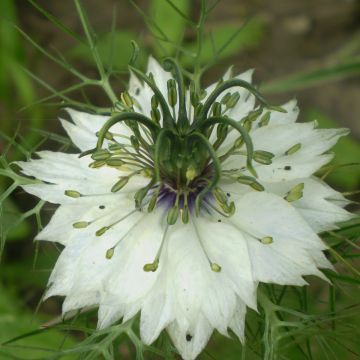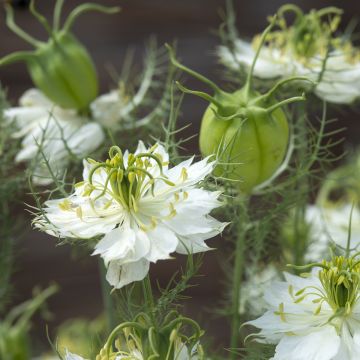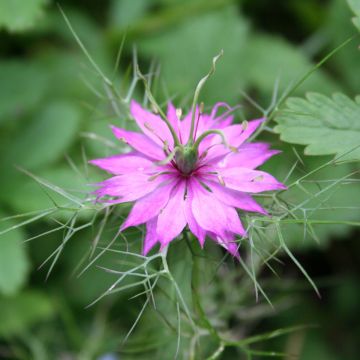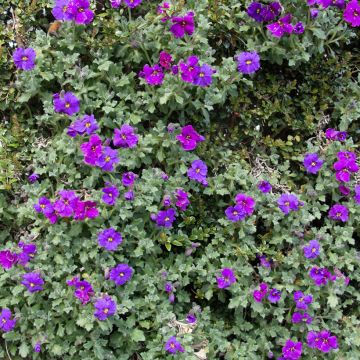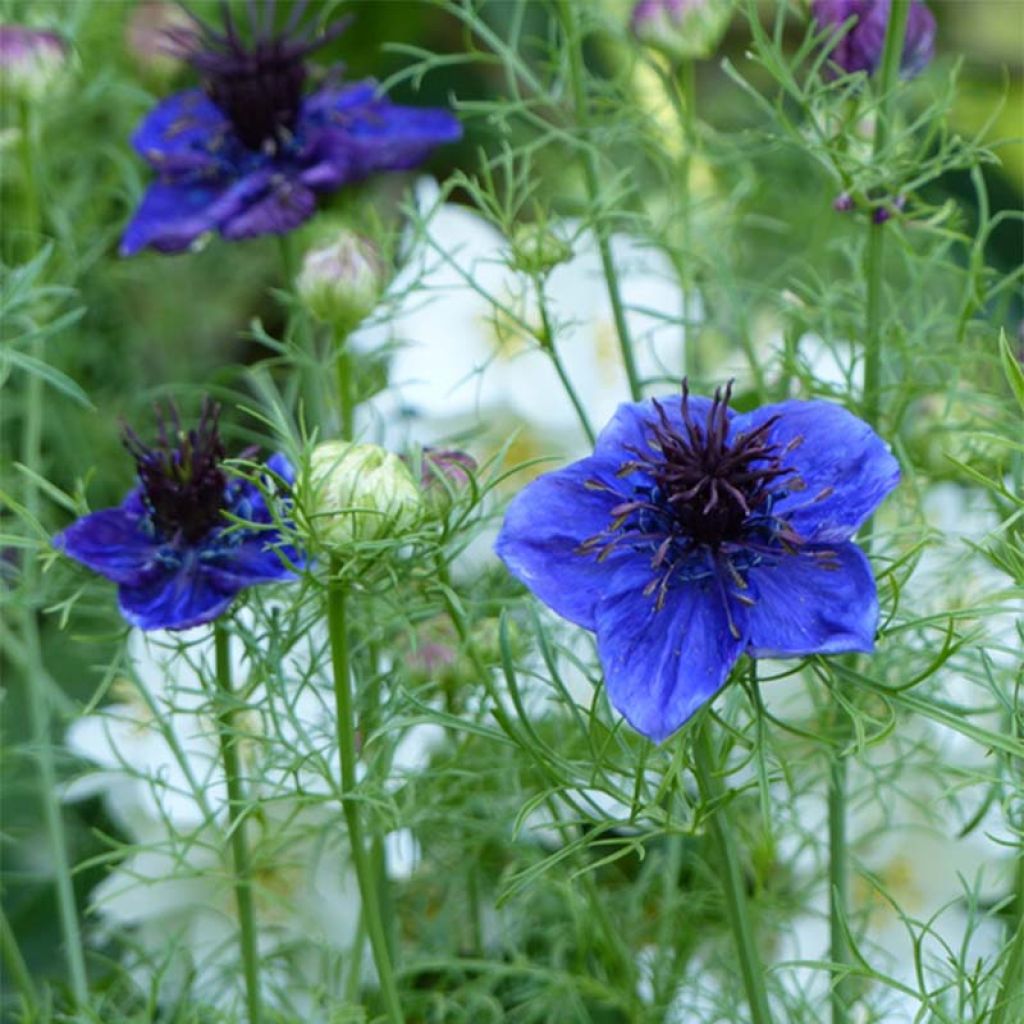

Nigella Midnight Blue - seeds
Nigella Midnight Blue - seeds
Nigella papillosa Midhigth Blue
love-in-a-mist
A bit disappointed, usually the love-in-a-mist flowers grow without any problems in my garden!
Stéphanie B., 08/10/2019
This item cannot be shipped to the selected country
Dispatch by letter from €3.90
More information
Schedule delivery date,
and select date in basket
This plant carries a 6 months recovery warranty
More information
We guarantee the quality of our plants for a full growing cycle, and will replace at our expense any plant that fails to recover under normal climatic and planting conditions.
Seed-only orders are dispatched by sealed envelope. The delivery charge for seed-only orders is €3.90.
Does this plant fit my garden?
Set up your Plantfit profile →
Description
Nigella Midnight Blue is a Spanish Nigella with large flowers that range from blue to dark blue around a very dark centre occupied by a curious almost black hooked pistil and dark purple stamens. These flowers are also precious for their architecture, nestled in cloudy foliage. Blooming longer than other Nigellas, in spring or summer depending on the climate, papillose Nigellas have original and decorative seed heads which are good for fresh or dried bouquets. They are sown directly in place, in light soil and in the sun, in early autumn or spring depending on the region.
The Midnight Blue Spanish Nigella is a fast-growing annual plant belonging to the Ranunculaceae family. The species is native to the Mediterranean region, particularly in Spain and Portugal, under hot and dry climates, in corn fields and on loamy-sandy or clay-loamy soil. "Midnight Blue" is a horticultural variety. It produces sturdy and branching stems, averaging 60-70 cm (24-28in) high (depending on growing conditions), adorned with numerous leaves divided into fine linear strips. It flowers from May-June to September, depending on the sowing date. The rather large flowers measure up to 5 cm (2in) in diameter. They emerge as yellowish buds, veined with green, then open up to petals that range from blue to dark violet-blue around a large pistil shaped like a "jesters cap" and numerous black stamens. The flowering is nectar-rich. The fruit is a fairly large capsule, topped with horizontally spreading styles. It contains smooth, grey-brown seeds.
Belonging to medicinal gardens, Love-in-a-Mist is very easy to grow in all well-drained soils. It is perfect everywhere: in natural gardens, rockeries and perennial beds where it lightens the flowering. It pairs well with bush roses and shrubby salvias. It fills empty spaces in record time and quickly creates a colourful, countryside composition with phacelias, California poppies, perennial flax or wild chicory. Midnight Blue Nigella is good for creating refined bouquets, combined with other blue or white flowers.
Report an error about the product description
Nigella Midnight Blue - seeds in pictures


Flowering
Foliage
Plant habit
Botanical data
Nigella
papillosa
Midhigth Blue
Ranunculaceae
love-in-a-mist
Southern Europe
Other Nigella -Love-in-a-mist seeds
Planting and care
Sowing the Midnight Blue Hairy Nigella is easy. Sow the seeds outdoors, directly in the open ground. Prepare the soil well to loosen and lighten it before sowing. Sow in rows spaced 30 cm (12in) apart, at a depth of 6 mm (0in). You can create beautiful flowering pots for spring by sowing the seeds in a cold greenhouse or conservatory in late summer and autumn. Thin out the seedlings to leave only one plant every 30 cm (12in).
Spanish nigellas love the sun and tolerate drought well, as they adapt their life cycle to the climatic conditions, flowering early in dry summer regions and all summer in cooler climates. These plants readily self-seed in the garden, but not always faithfully.
Sowing period
Intended location
-
, onOrder confirmed
Reply from on Promesse de fleurs
Flower seeds
Haven't found what you were looking for?
Hardiness is the lowest winter temperature a plant can endure without suffering serious damage or even dying. However, hardiness is affected by location (a sheltered area, such as a patio), protection (winter cover) and soil type (hardiness is improved by well-drained soil).

Photo Sharing Terms & Conditions
In order to encourage gardeners to interact and share their experiences, Promesse de fleurs offers various media enabling content to be uploaded onto its Site - in particular via the ‘Photo sharing’ module.
The User agrees to refrain from:
- Posting any content that is illegal, prejudicial, insulting, racist, inciteful to hatred, revisionist, contrary to public decency, that infringes on privacy or on the privacy rights of third parties, in particular the publicity rights of persons and goods, intellectual property rights, or the right to privacy.
- Submitting content on behalf of a third party;
- Impersonate the identity of a third party and/or publish any personal information about a third party;
In general, the User undertakes to refrain from any unethical behaviour.
All Content (in particular text, comments, files, images, photos, videos, creative works, etc.), which may be subject to property or intellectual property rights, image or other private rights, shall remain the property of the User, subject to the limited rights granted by the terms of the licence granted by Promesse de fleurs as stated below. Users are at liberty to publish or not to publish such Content on the Site, notably via the ‘Photo Sharing’ facility, and accept that this Content shall be made public and freely accessible, notably on the Internet.
Users further acknowledge, undertake to have ,and guarantee that they hold all necessary rights and permissions to publish such material on the Site, in particular with regard to the legislation in force pertaining to any privacy, property, intellectual property, image, or contractual rights, or rights of any other nature. By publishing such Content on the Site, Users acknowledge accepting full liability as publishers of the Content within the meaning of the law, and grant Promesse de fleurs, free of charge, an inclusive, worldwide licence for the said Content for the entire duration of its publication, including all reproduction, representation, up/downloading, displaying, performing, transmission, and storage rights.
Users also grant permission for their name to be linked to the Content and accept that this link may not always be made available.
By engaging in posting material, Users consent to their Content becoming automatically accessible on the Internet, in particular on other sites and/or blogs and/or web pages of the Promesse de fleurs site, including in particular social pages and the Promesse de fleurs catalogue.
Users may secure the removal of entrusted content free of charge by issuing a simple request via our contact form.
The flowering period indicated on our website applies to countries and regions located in USDA zone 8 (France, the United Kingdom, Ireland, the Netherlands, etc.)
It will vary according to where you live:
- In zones 9 to 10 (Italy, Spain, Greece, etc.), flowering will occur about 2 to 4 weeks earlier.
- In zones 6 to 7 (Germany, Poland, Slovenia, and lower mountainous regions), flowering will be delayed by 2 to 3 weeks.
- In zone 5 (Central Europe, Scandinavia), blooming will be delayed by 3 to 5 weeks.
In temperate climates, pruning of spring-flowering shrubs (forsythia, spireas, etc.) should be done just after flowering.
Pruning of summer-flowering shrubs (Indian Lilac, Perovskia, etc.) can be done in winter or spring.
In cold regions as well as with frost-sensitive plants, avoid pruning too early when severe frosts may still occur.
The planting period indicated on our website applies to countries and regions located in USDA zone 8 (France, United Kingdom, Ireland, Netherlands).
It will vary according to where you live:
- In Mediterranean zones (Marseille, Madrid, Milan, etc.), autumn and winter are the best planting periods.
- In continental zones (Strasbourg, Munich, Vienna, etc.), delay planting by 2 to 3 weeks in spring and bring it forward by 2 to 4 weeks in autumn.
- In mountainous regions (the Alps, Pyrenees, Carpathians, etc.), it is best to plant in late spring (May-June) or late summer (August-September).
The harvesting period indicated on our website applies to countries and regions in USDA zone 8 (France, England, Ireland, the Netherlands).
In colder areas (Scandinavia, Poland, Austria...) fruit and vegetable harvests are likely to be delayed by 3-4 weeks.
In warmer areas (Italy, Spain, Greece, etc.), harvesting will probably take place earlier, depending on weather conditions.
The sowing periods indicated on our website apply to countries and regions within USDA Zone 8 (France, UK, Ireland, Netherlands).
In colder areas (Scandinavia, Poland, Austria...), delay any outdoor sowing by 3-4 weeks, or sow under glass.
In warmer climes (Italy, Spain, Greece, etc.), bring outdoor sowing forward by a few weeks.

































